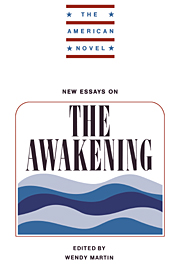Book contents
- Frontmatter
- Contents
- Series Editor's Preface
- 1 Introduction
- 2 Tradition and the Female Talent: The Awakening as a Solitary Book
- 3 Revolt Against Nature: The Problematic Modernism of The Awakening
- 4 The Half-Life of Edna Pontellier
- 5 Edna's Wisdom: A Transitional and Numinous Merging
- Notes on Contributors
- Selected Bibliography
1 - Introduction
Published online by Cambridge University Press: 06 January 2010
- Frontmatter
- Contents
- Series Editor's Preface
- 1 Introduction
- 2 Tradition and the Female Talent: The Awakening as a Solitary Book
- 3 Revolt Against Nature: The Problematic Modernism of The Awakening
- 4 The Half-Life of Edna Pontellier
- 5 Edna's Wisdom: A Transitional and Numinous Merging
- Notes on Contributors
- Selected Bibliography
Summary
In a portrait of Kate Chopin (Katherine O'Flaherty Chopin, 1850–1904), her son Felix remembers her as being available to her three sons and three daughters at all times. Describing his mother as being constantly interrupted by her children as she read or wrote in her Morris chair in the living room that was filled with books and decorated with a few simple paintings, he notes that there was a statue of a naked Venus on one of the bookshelves. This icon of female eros represents the primary concern of Chopin's fiction – the celebration of female sexuality, and the tension between erotic desire and the demands of marriage, the family, and a traditional society.
Kate Chopin juggled the demands of her writing career and motherhood with extraordinary success. Although she often longed for privacy for her work as well as greater personal freedom, she carried out her domestic and social responsibilities with apparent equanimity. In spite of the fact that she was widowed in her early thirties and was left with six children to raise, she established a very comfortable home for her family and was known throughout St. Louis for her thriving household and her salon, which was frequented by the city's most prominent intellectuals and artists. By the mid-1890s, Kate Chopin was a nationally recognized novelist, short story writer, essayist and reviewer. She wrote more than one hundred short stories, many of which were published in Vogue, The Century, and the Atlantic and were later collected in Bayou Folk (1894) and A Night in Acadie (1897).
- Type
- Chapter
- Information
- New Essays on The Awakening , pp. 1 - 32Publisher: Cambridge University PressPrint publication year: 1988
- 2
- Cited by

